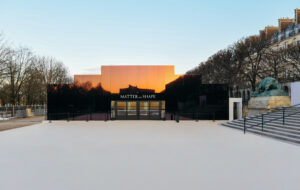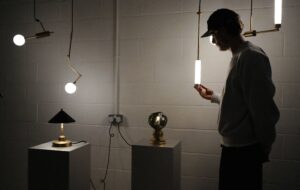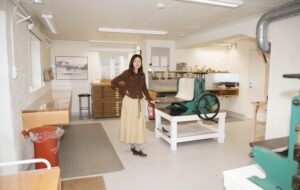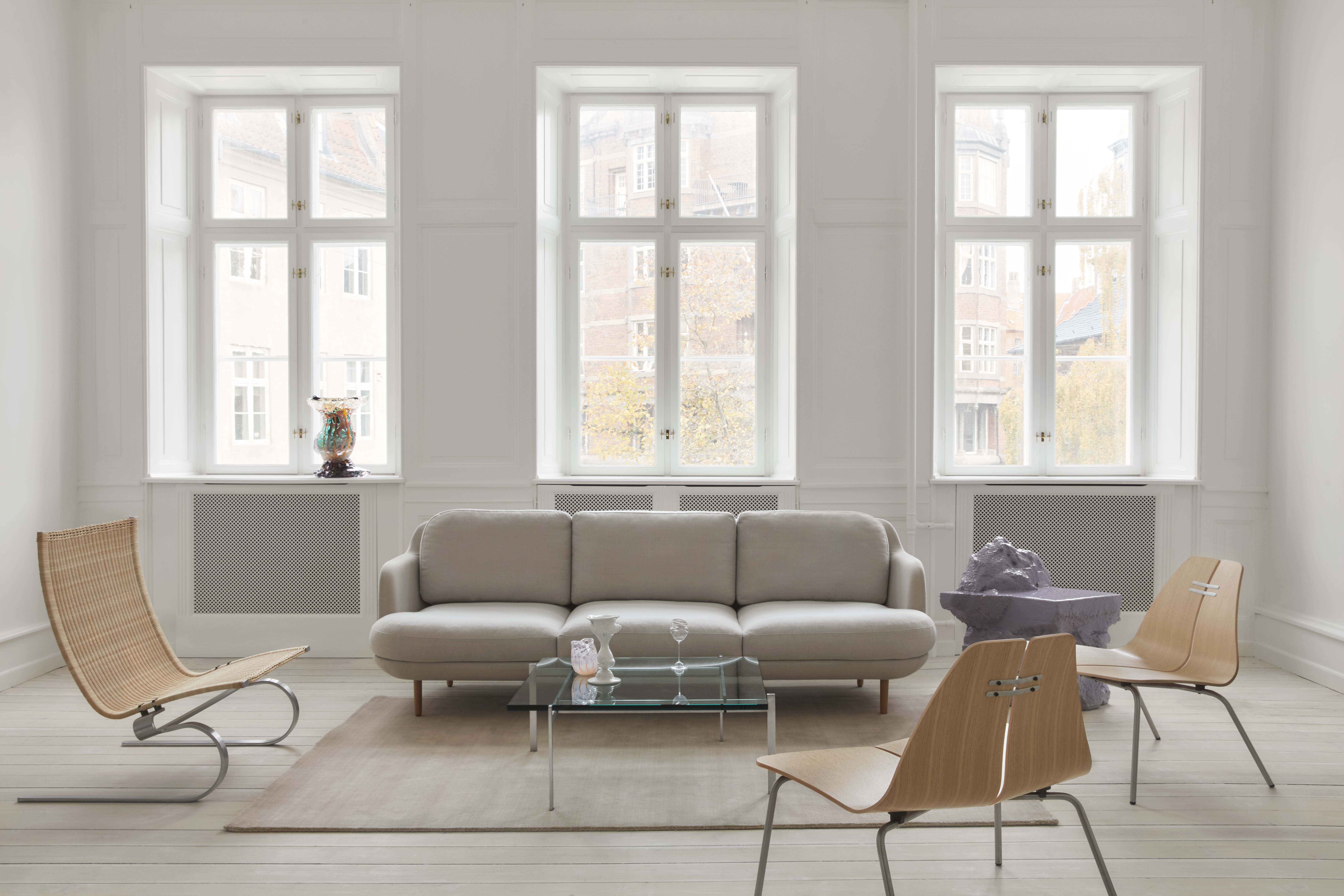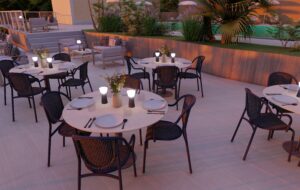



words Marcus Fairs
The singular haircut of Matali Crasset has been freshly clipped in our honour. “I just did it this morning,” she admits, brushing at the telltale shavings still adhering to her face and neck. “I go to a Chinese place nearby.”
She’s worn the striking Joan of Arc-style reverse tonsure since she was at school. “I tried lots of different haircuts and I stopped at this one. I feel really comfortable with it; it really lets me breathe. It’s a cooling system.”
Striking yet pragmatic, but also odd and somewhat disconcerting, Crasset’s haircut is as uncompromising as her work. She is one of the world’s leading female designers and definitely the most versatile: her interiors, products and furniture display a consistent willingness to defy convention and challenge typologies.
“What I am trying to do is break the codes,”she says in her strangely high-pitched French accent. “If we only change furniture in a superficial way, like the colours, materials and shapes, we are still living in the same way. I try to bring a new logic to life.”
We are speaking in her live/work studio in a converted print works in Belleville, a low-rise, workaday district full of Chinese restaurants and shops in north-east Paris. Her staff of six work on the ground floor; Crasset lives upstairs with her partner and two young children.
Much of Crasset’s furniture explores ways of making objects as flexible as possible. The long table we are sitting at has a top consisting of four removable sections that double as trays or shelves, while a collection of PVC-covered foam shapes has been stacked into a sofa-like assemblage against one wall. The pieces can equally be arranged to form armchairs, a bed or a children’s playground.
“Take this sofa, for example,” she says, elaborating on her design philosophy. “In every house you have a big sofa. Sofas were made initially for speaking together – it’s a ‘salon’. Today the sofa is a status object; it is a huge investment and it means that you keep it for at least ten years. I really don’t understand how people can stay with the same structure for ten years. The family changes; you have kids. You need space. That is why I try to break the codes and fight against this idea of status. To gain liberty in order to really use your interiors as you want.”
Crasset was born in 1965 in the tiny farming village of Châlons-en-Champagne in north-eastern France where her father farmed cereals and sugar beet. She felt stifled by the rural life and yearned for something better, but didn’t quite know what. “As a child I was suffering from being in the countryside,” she recalls. “When I was sixteen my dream was to go to the town. I had a dream but I didn’t know what I could do in the big city.”
She studied marketing until, part way through the course, her class was assigned to develop a launch strategy for a new perfume. Crasset became fascinated by the packaging of the imaginary product. “I went home and tried to design the bottle and the packaging because for me the final product people would get was more important than all the things that come before. So I started to get information about who does this job. I found out it was done by designers so I tried to get information about how you could become a designer. Suddenly all became clear, it was the job for me.”
At age 20 she enrolled at design school in Paris and threw herself into her belated métier. Success came quickly and she describes her rapid ascent as “like a fairytale”. In 1992, when her graduation project was exhibited at the Milan Triennial, she contacted her hero, Italian designer Denis Santachiara. “I called him and half an hour later I had an appointment. It all happened quite fast. He liked my work and so I started working for him.”
After a year in Milan, she returned to Paris and wrote three letters to potential employers, including one to Philippe Starck. “I was a little bit lost because I didn’t know where to go. I thought it would be interesting to work in the Starck studio. He was able to touch every kind of project, and I was really curious to understand how he could do that. Because he is a little bit greedy, like me in fact. When you come a little bit late to something, you want to work. You always say that you will stop one day but it is impossible. Perhaps the link between us is this interest with no limits.”
Starck hired her and she spent a few months designing furniture for him until she got a huge break – he was commissioned to overhaul the entire project range of the giant French state-owned electronics company Thomson, and Starck asked Crasset to head up the brand’s design studio. Involving around 120 product launches a year, the exercise was one of the bravest design initiatives ever undertaken by a major brand. Starck was generous enough to allow Crasset equal billing on the range: each project bears the legend “art direction by Starck; design by Matali Crasset”.
Crasset worked for Thomson and Starck for almost five years, overseeing a stream of quirky domestic electronic products that were radical for their time, including the Soundstation radio alarm, with its protruding funnel-shaped loudspeaker. “It was a brave revolution,” Crasset says. “The president [of Thomson] wanted to change the company very fast and Starck was chosen to push. We could have made an evolution but it would not have been fast enough.”
The project was not just a styling exercise: Starck and Crasset tried to simplify the products by removing the superfluous functionality and making products easier to use. “The problem was that we were pushing a little bit too fast,” she says. “The market was not yet ready for products like this. At the time everything else was black boxes. Sales staff in [French electrical retailers] Fnac or Darty were used to speaking about the picture and the sound. They had to start speaking about the design so they were lost.”
Crasset describes the success of the project as “mixed” – some of the products are still on sale today, which is unprecedented in an industry where product ranges are revamped every year – but was ultimately abandoned when broader structural and financial problems with the Thomson group led to its sale to a Korean company, which cancelled the contract with Starck.
By this time, however, Crasset had already built up a name for herself as a freelance designer, and five months after the Thomson work ended, she left Starck to set up her own studio. “Starck was so strong so I felt I had to do my own work in the weekends and at the evenings with my own personality. So I did not have to start from zero.”
An early success was her 1995 “hospitality tower” – a felt and foam guest futon with integrated reading light and alarm clock that rolls up into a tight cylinder when not in use. Intended for occasional guests, the project was called Quand Jim monte à Paris [When Jim comes to Paris] after a cousin of hers.
This set the tone for a string of projects that explored flexibility, hospitality and contemporary modes of living, culminating in her best-known interior project, the 2003 Hi Hotel in Nice.
Crasset designed almost every element of this 38-room boutique hotel herself, including the interiors, furniture and fittings, and even the graphics and service concept. Based around the notion that freedom is the greatest luxury, the hotel encourages guests to explore new ways of living. The nine different room concepts include Techno Corner – a hi-tech boudoir replete with projectors, computers and stereo-embedded sofas – and Happy Day – which transforms from a daytime lounge into a bedroom at the click of a switch.
It’s a world away from the standard hotel where guests are made to feel at home. “It is for curious people,” she says rather defensively. “We are not obliging people to come and stay. We never work for specific types of people with a marketing target. I don’t want to work for everybody. I just want to help the people who are conscious of not wanting to be surrounded by outdated products. It’s like I say in French: ‘accompagnée dans le contemporaine’; to take the hand of somebody and help them live in today’s world.”

